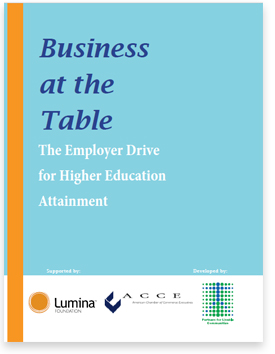Partners for Livable Communities (Partners), in partnership with the American Chamber of Commerce Executives (ACCE) and with funding from Lumina Foundation, releases Business at the Table: The Employer Drive for Higher Education Attainment. This collection of case studies was created during the Business at the Table initiative to develop strategies for improving U.S. higher education attainment (degrees and credentials) through chamber of commerce and business involvement.
This compendium of case studies provides business and chamber leaders the perspective to further Lumina’s Goal 2025: to increase the proportion of Americans with high-quality degrees and credentials to 60 percent by the year 2025. Included are programs led by chambers of commerce, two-year and four-year colleges and universities, and national and local higher education achievement programs. Interviews were conducted with the CEO or director of each program, providing personal accounts of trials and victories on the road to success. Case studies explore the history of the program or organization, key players, geographic context, specific place-based economic challenges that were overcome, and the short and long-term goals that have been achieved.
A window into the detailed accounts, challenges, and success stories of higher education achievement programs around the nation, this report will help chambers and businesses move forward on the path toward Lumina’s Goal 2025. These case studies outline best practices that can be adapted to help meet the needs and achieve the goals of communities across the country. By learning from these examples and creating their own unique strategic plans, chamber and business leaders can become spokespeople for this important work and take action in their own communities.
This compendium of case studies provides business and chamber leaders the perspective to further Lumina’s Goal 2025: to increase the proportion of Americans with high-quality degrees and credentials to 60 percent by the year 2025.


Most Commented